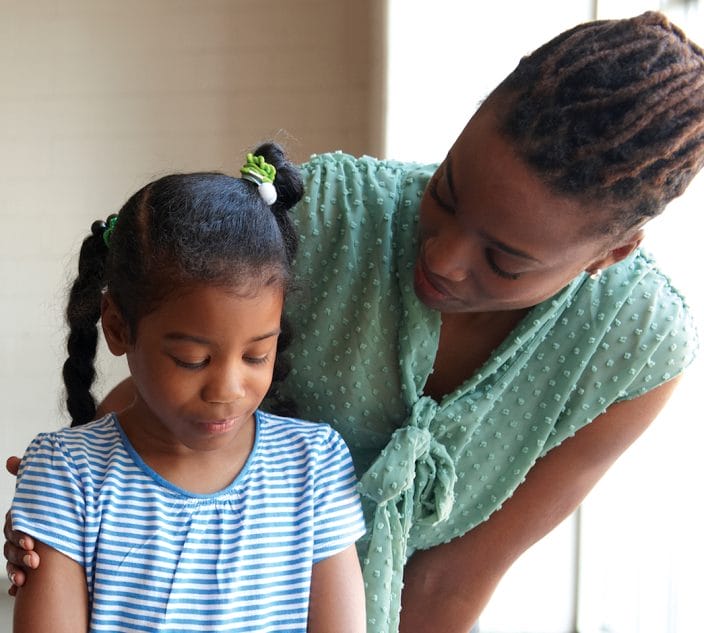
In the radio documentary she made, Sabrina Shannon, just shy of 10, holds the microphone in front of her mother. She asks what it’s like to have a daughter with food allergies. Then she adds: “Do you think I’m beautiful?”
With mock earnestness, Sara Shannon replies, “I think you’re probably the best-looking girl in the world.” Sabrina collapses in a fit of giggles.
SOME KIDS just have that energy, that sparkle in the eyes, that irrepressible spirit. Sabrina Shannon was one of those, a pure pistol of a kid. Her personality shone through in the radio documentary she produced with her aunt, Kathleen Whelan, which originally aired on a CBC Radio program back in 2001.
The documentary was a first-person narrative about living with allergies. Sabrina, who was at risk of anaphylaxis to peanut, dairy and soy, proved a natural at the mike. She interviewed her girlfriends, her mother and gave her own views of life with food allergies. It was a great 12 minutes of audiotape.
But this anecdote takes place in the past tense. Sabrina’s tale turns, sadly, to one of tragedy. She is the food-allergic kid who didn’t make it, the bright light extinguished.
On September 30, 2003, Sabrina died in hospital following an anaphylactic reaction. Her mom, her dad, her Aunt Kathleen, her many other relatives and friends have been devastated by her death. But this is also a story of hope born of tragedy, of an organized effort to do justice to Sabrina’s memory by making sure no other child suffers a similar, likely preventable death.
Sabrina, the girl who had her final lunch from the high school cafeteria at the age of 13, became the rallying point for a new law. One that requires anaphylaxis safety plans in schools in Ontario, the biggest Canadian province. It is legislation that would come to influence change in schools across North America.
She Thought It was Her Asthma
On September 29, 2003, Sabrina balked at her mother’s efforts to have her take yet another allergy-friendly sandwich to school. It was the end of the teen’s first month of Grade 8 at Bishop Smith Catholic High School in Pembroke, a small city in the Ottawa Valley. She told her mom that the previous week, she’d eaten French fries once in the cafeteria after checking that they didn’t contain any of her allergy triggers. The fries were safe – and tasty. She wanted eat them again at lunch today.
Sara Shannon resisted at first, but she also trusted Sabrina’s judgment. Her daughter had always been responsible about her food allergies. She asked the right questions before eating, and carried her epinephrine auto-injector in her backpack, along with her asthma puffer. Sara agreed.
Around 11:40 that morning, Sabrina and her best friend went to the cafeteria. Sabrina ordered fries after again checking that they were cooked in vegetable oil rather than peanut oil.
In the class after lunch, Sabrina began to wheeze. Thinking she was having an asthma attack, the teen headed for the school office at the other end of the building. By the time she got there, Sabrina was having serious respiratory trouble. She kept repeating, “It’s my asthma.”
Dairy Contact and the Tragedy
A teacher raced to Sabrina’s locker to get her EpiPen auto-injector in case it was in fact her food allergies; school officials called an ambulance. Sabrina collapsed and lost consciousness, going into cardiac arrest before the device could be administered, before the ambulance arrived.
The girl’s heart was restarted at the local hospital and she was airlifted to the Children’s Hospital of Eastern Ontario in Ottawa. Sabrina’s young heart and lungs were strong, but she’d suffered significant brain damage.
Later, it would be determined that her devastated condition was the result of anaphylaxis due to food allergy. The coroner posited that the allergic trigger was dairy protein. Sabrina would have been exposed to dairy through tongs used to lift her fries. Those same tongs had been used to serve orders accompanied by poutine, the French Canadian topping of gravy and melted cheese curds. She would have been allergic to the curds.
On September 30, a day after her reaction, Sabrina was removed from life support and died.
At a press conference in Ottawa almost a year after Sabrina’s death, Dr. Andrew McCallum, the chief coroner for Eastern Ontario, called for the implementation of comprehensive anaphylaxis management plans in schools. He said high schools, in particular, needed to pay better attention to the need to protect allergic children such as Sabrina. All schools, he said, should keep epinephrine auto-injectors available in the school office and staff and teachers must have proper training on the use of the device.
Then Sara Shannon stepped up to the microphone to tell the assembled media that, while her daughter lay dying, “I made a promise to Sabrina that I would do whatever is possible to prevent this fate from happening to any other child. Please help me to keep my promise,” she said softly.
The Fight for a School Law
Sabrina Shannon died two days before the Liberal Party was voted into power in the province of Ontario. The party even had a line in its platform promising that, if elected, it would require public schools to have anaphylaxis plans based on province-wide standards. Such words were encouraging to those who had been lobbying, even before Sabrina’s death, to pass a law requiring school allergy procedures.
Dave Levac, a Liberal MPP for Brantford, Ontario and a former high school principal, first introduced a private member’s bill to protect anaphylactic students in provincial elementary and secondary schools in June 2002. While many schools had anaphylaxis plans in place, he thought it was dangerous that the standard was not consistent.
His view is that uniform procedures will avoid “the arguing between schools and parents, the gnashing of teeth in the protection of a child.”
His first bill died on the order paper under the previous Conservative government, as did his next effort. But with the Liberals barely sworn in to office, Levac’s third attempt – the proposed Act to Protect Anaphylactic Pupils – became Bill 3, numbered near the top of the pile.
The MPP and Cindy Paskey, then president of the Niagara region’s anaphylaxis association, had worked together organizing letter campaigns and petitions. They were elated as Bill 3 passed second reading on December 4, 2003. Now it just needed to go to a committee for a consultation process before a final reading enshrined it in law.
But for more than a year, the bill simply sat. By March 2005, Paskey and Laurie Harada, the executive director of Anaphylaxis Canada, were concerned. The clock was ticking on Bill 3 – if it didn’t get passed during this session of the legislature, it would die.
The Bill Becomes ‘Sabrina’s Law’
Then the Shannon family stepped in to help, and Sabrina soon became the human face of this legislation. Anaphylaxis Canada dubbed Bill 3, “Sabrina’s Law,” driving home Shannon’s point from that Ottawa press conference that no other child should suffer her daughter’s fate. Sara Shannon and Laurie Harada met with government officials who were receptive to their concerns.
After all the delays, on May 16, 2005, the final vote on Bill 3 was held in the legislature. As parents and allergic children watched intently from the public gallery, all three parties voted in favor of Sabrina’s Law. It passed unanimously.
The law, which took effect January 1, 2006, requires Ontario school boards to have all principals implement anaphylaxis plans that include: strategies to reduce exposure to allergens, procedures to communicate to parents, students and employees about life-threatening allergies, and regular training on dealing with life-threatening allergies for teachers and staff.
In addition, principals are required to: develop an individual plan for each student at risk of anaphylaxis, maintain a file that lists that student’s prescriptions and emergency contacts and ensure that parents enrolling pupils supply information on a child’s allergies.
What the Liberal government didn’t realize, is that the progress of Sabrina’s Law was not just watched by relatives of anaphylactic students in Ontario. The legislation was also drawing attention across the United States and the rest of Canada.
Sabrina’s Law: Far-Reaching
In 2004, Sabrina’s aunt Kathleen Whelan wrote to Robert F. Kennedy Jr., who was on the board of the Food Allergy Initiative (now FARE), the nonprofit research and education organization. She had learned that Kennedy has a son with peanut allergy. Whelan let him know about Sabrina’s tragedy and that the family wanted to tell her story so people would appreciate the gravity of anaphylaxis.
Kennedy was moved. For its annual gala journal, he asked FAI to publish a story that Whelan, a writer, had composed about Sabrina’s death. As guests dined and raised tens of thousands of dollars for research, they also read Whelan’s words about her niece – and the hole her death left in so many hearts.
Sabrina’s family impressed FAI and Rachel Sanzari, who was its administrator. “It’s just amazing that they took a tragedy and used it to make anaphylaxis an issue,” she said in May 2005. A law in a province the size of Ontario “will serve as a model here in the United States.” [Editor’s note: Today, there are several state allergy laws and policies in the U.S., and a section in the federal FAAMA act of 2011.]
“No matter where you are,” said Anaphylaxis Canada’s Harada, “the issues are very similar, the emotional aspect and what’s going on in schools. So many jurisdictions are looking at what’s happening here because nobody seems to have any law. There are guidelines, there are directives, there are ministry of education policies, but there’s no law. This is precedent-setting.”
In the end, reminds Levac, Sabrina’s Law is about saving students’ lives. It’s a point that is hard to forget around Sara Shannon.
“I loved Sabrina so much. I miss her terribly,” she says. “We have to make sure this doesn’t happen to another child. When everything is done, everything is in place, every procedure, every emergency plan, then if a child dies, we can say, ‘there was nothing we could do’. But when we know that there is something we can do to prevent this, we can’t live in a world of denial.”
Sabrina’s Law fulfills a promise that Shannon desperately wanted to keep.
Reprinted from Allergic Living’s Spring 2005 issue. Updated February, 2011.
Related Reading:
Know Your Food Allergy Rights at School
Honoring Oakley Debbs: the Meaning of Red Sneakers Day
Anaphylaxis But No Epinephrine: An Epidemic of Hesitation





